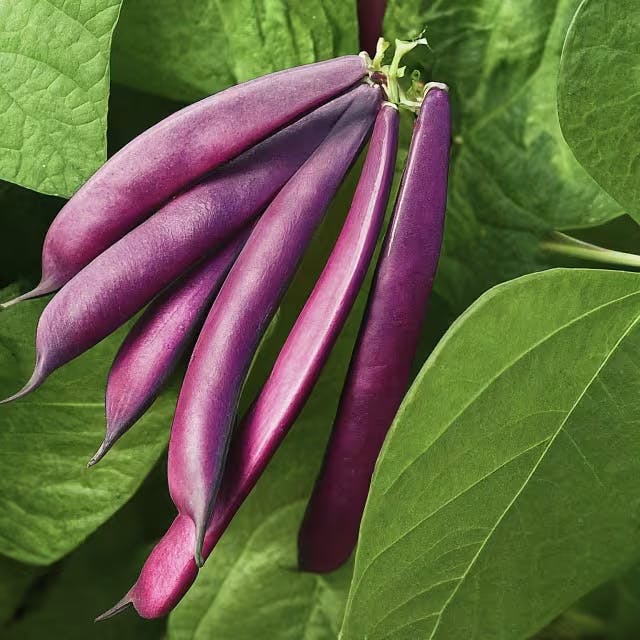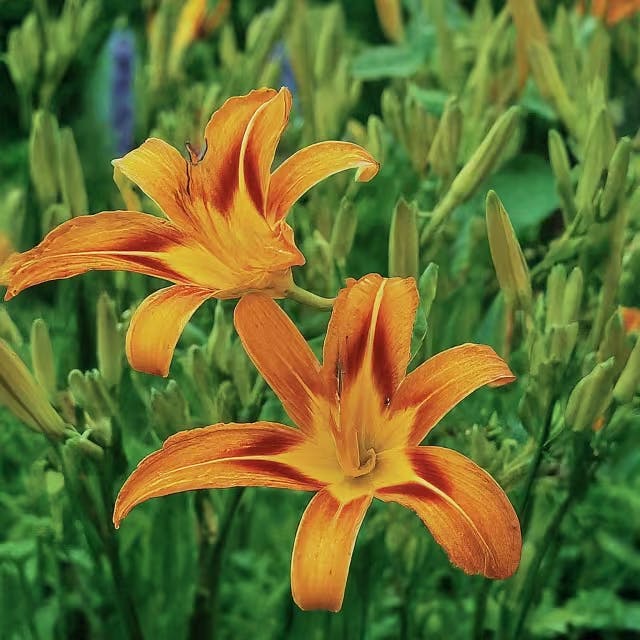Growing Purple Podded Bush Beans: A Colorful Endeavor
Go4Turf
February 13, 2024

Embarking on the journey of growing purple podded bush beans presents a unique and colorful endeavor for gardeners of all levels. With the allure of their ease of growth, fun harvesting experience, and delicious taste, these vibrant beans are a standout addition to summer gardens. Whether you're navigating through the myriad of bush bean varieties for container gardening, seeking heat-resistant cultivars, or simply aiming to add a splash of color to your vegetable patch, this guide on growing purple podded bush beans will lead you through selecting the right variety, caring for your plants, and ultimately, savoring your colorful harvest.
Key Takeaways
Purple podded bush beans are an attractive and easy-to-grow choice for gardeners of all levels, adding a fun element to the harvesting process and a pop of color to the garden.
Selecting the right variety of purple podded bush beans is crucial, with factors like size (for container gardening), heat resistance, and color intensity to consider.
Proper planting and care are key to a successful harvest, including considerations for soil quality, watering, and sun exposure.
The unique color and delicious taste of purple podded bush beans make them a delightful addition to meals, enhancing both the visual appeal and flavor of dishes.
Why Grow Purple Podded Bush Beans?
Growing purple podded bush beans isn't just a gardening activity; it's an avenue for both new and experienced gardeners to bring a splash of color to their gardens. Unlike the common green varieties, these purple beans offer a visually striking contrast against the green foliage, making your garden stand out.
Visual Appeal: These beans provide a unique aesthetic element to your garden landscape.
Easy to Spot: The vibrant purple pods are easier to see against the green leaves, making harvesting less of a chore.
Nutritional Value: Like other beans, they are a great source of vitamins, minerals, and fiber, contributing to a healthy diet.
For those keen on sustainable gardening practices, it’s worth noting that these beans, like all legumes, have the ability to fix atmospheric nitrogen. This means they can enrich the soil with this critical nutrient, reducing the need for synthetic fertilizers.
Planting them requires minimal specialized care beyond what's standard for other bush beans. While they thrive in moderate fertility, taking steps to ensure low humidity and good air circulation can help mitigate common issues like white mold, as reported in growing tips shared by Fedco Seeds. It's also encouraging for gardeners aiming at an organic garden to know that the seeds are non-GMO, free of neonicotinoids and fungicides.
Moreover, for those looking to turn their black thumb green or to prepare their garden for the changing seasons, implementing general gardening tips from articles like Transform Your Black Thumb into a Green Thumb: Essential Tips and Preparing Your Garden for Fall: Tips and Tricks, along with planting these beans, can make a significant positive impact on your gardening experience.
Growing these beans is a straightforward way to add a unique and colorful twist to your vegetable garden, underscored by the joy and anticipation similar to what's described in The Joy of Receiving Seed Packages: A Gardener's Delight. Whether for their stunning appearance, nutritional benefits, or the ease of growing, purple podded bush beans make a worthy addition to any garden.

Choosing the Right Variety for Your Garden
When embarking on the colorful journey of growing purple podded bush beans, selecting the right variety plays a crucial role in your garden's success. Different varieties offer unique features such as size, taste, and growth habits, making it important to choose one that aligns with your gardening goals and climate conditions. For insights on the importance of choosing the right plant varieties, including considerations like maturity time and disease resistance, Danny Lipford's expert advice offers a great starting point.
Here are a few popular varieties known for their vibrant hue and delicious taste:
Royal Burgundy: These beans thrive in cooler temperatures, making them an excellent choice for gardeners in northern climates. They also boast a fast maturation rate.
Purple Queen: Known for their heat tolerance, Purple Queen beans are perfect for warmer climates. They produce a plentiful harvest and have a rich, earthy flavor.
Purple Teepee: Their unique growth pattern makes them easy to harvest, and they do well in a variety of climates. Ideal for container gardening as well.
Each variety has its own set of requirements for sunlight and water, along with a specific maturity timeline. Matching these requirements with your garden’s conditions is key to ensuring a bountiful harvest. Utilizing resources like the essential gardening tips guide can further increase your chances of a successful growth season, providing you with knowledge on sunlight, water, nutrients, and more.
Remember, the beauty of gardening lies in experimentation and learning. Choosing the right variety of purple podded bush beans for your garden can be a rewarding endeavor, offering both aesthetic appeal and delicious outcomes.
Planting and Care Tips for Purple Podded Bush Beans
For a successful harvest of purple podded bush beans, proper planting and care are key. When sowing seeds directly into the garden, ensure the soil temperature has reached at least 60°F. Plant seeds 1 inch deep and 2 inches apart in rows, with each row spaced 18 inches apart. This spacing allows for adequate airflow and sunlight, crucial elements for plant health. To boost your gardening skills, consider incorporating tips from Transform Your Black Thumb into a Green Thumb: Essential Tips, focusing on the importance of sunlight, water, and nutrients.
Watering is essential for bean plants, especially during flowering and pod formation stages. Consistently moist, but not waterlogged, soil will ensure a robust yield. Mulching around plants can help retain soil moisture and temperature, complementing fall gardening preparations. Fertilization should be minimal as beans fix their own nitrogen, though a balanced, all-purpose fertilizer can be applied when pods begin to form if plants appear lackluster.
Bean plants are generally trouble-free but watch for common pests like bean beetles. Regular inspection and prompt removal of affected leaves can keep issues at bay.
Harvest purple podded bush beans when pods are full but before the seeds bulge, typically 50-60 days after planting. Regular picking encourages continuous production. For more on bean varieties and their unique aspects, Savvy Gardening and Journey With Jill offer detailed insights into choosing the right beans for your garden, enhanced by firsthand experiences and preferences.
Enjoy the colorful addition to your garden and the delicious, nutritious rewards of your care and dedication.
Harvesting and Enjoying Your Colorful Beans
Harvesting your purple podded bush beans at the right time ensures they are tender and flavorful. Look for pods that are firm and have a vibrant purple color, typically when they are about four to six inches long. Gently pull or snap them off the plant, being cautious not to damage the bush. Regular harvesting encourages the plant to produce more beans over the season.
Enjoy your freshly picked beans in a variety of dishes. These colorful beans can be steamed, blanched, or sautéed. Keep in mind, the unique purple hue transforms to green when cooked, which can be a delightful surprise on the dinner table. For inspiration on incorporating these beans into your meals, here are some culinary ideas to explore.
If you're looking to store your harvest, purple podded bush beans freeze well. Blanch them first for two to three minutes, plunge into ice water to halt cooking, then dry and place in freezer bags. This method preserves their taste and texture for future enjoyment.
To ensure your garden continues to thrive, consider implementing essential gardening tips, or if you're preparing for the cooler months, here's how to transition your garden for fall. Gardeners aiming for variety in their harvest might also be interested in growing ginger and galangal, which can add spice and diversity to your culinary endeavors. Embarking on the colorful journey of growing purple podded bush beans not only beautifies your garden but also rewards you with a bounty of nutritious and delicious produce. By choosing the right variety, providing the proper care, and harvesting at the perfect time, you can enjoy these vibrant beans in countless dishes throughout the season. This endeavor proves to be a rewarding way to enhance both the aesthetics and the productivity of your garden space.
Frequently Asked Questions
What makes growing purple podded bush beans a unique addition to your garden?
Growing purple podded bush beans brings a striking visual appeal and practical benefits to your garden. Their vibrant pods make harvesting easier against the green foliage, and like other beans, they offer nutritional value with vitamins, minerals, and fiber. These beans also enrich the soil by fixing atmospheric nitrogen, reducing the need for synthetic fertilizers. With minimal special care required and their non-GMO, neonicotinoid, and fungicide-free seeds, they represent an attractive, sustainable choice for both novice and experienced gardeners looking to add a splash of color and biodiversity to their gardens.
How do purple podded bush beans contribute to sustainable gardening practices?
Purple podded bush beans contribute to sustainable gardening practices through their nitrogen-fixing ability, enriching the soil and reducing the need for synthetic fertilizers. They are non-GMO and free of neonicotinoids and fungicides, supporting organic gardening efforts. Additionally, their ease of growth, minimal specialized care requirements, and adaptability to organic gardening practices make them an environmentally friendly and sustainable choice for gardeners.
What are the key tips for planting and caring for purple podded bush beans to ensure a successful harvest?
For a bountiful harvest of purple podded bush beans, plant in well-drained soil with full sun exposure, ensuring soil temperature is above 60°F. Space seeds 1 inch deep and 2 inches apart, using rows 18 inches apart to promote good airflow. Water consistently, especially during flowering and pod development, and practice minimal fertilization since beans fix their own nitrogen. Mulch to retain soil moisture. Harvest beans when pods are firm and brightly colored, about four to six inches long, to enjoy their peak flavor and texture. Regular harvesting encourages further production.
How can you choose the right variety of purple podded bush beans for your garden's climate and conditions?
To select the right variety of purple podded bush beans for your garden, consider your climate and garden conditions. Look at varieties like Royal Burgundy for cooler climates, Purple Queen for warmer areas, and Purple Teepee for a broad range of conditions, including container gardening. Match the sunlight, water, and soil requirements of the variety to your garden's specific conditions. Utilizing resources and tips on gardening best practices can help ensure a successful and bountiful harvest.
What is the best way to harvest and enjoy the flavor of purple podded bush beans?
Harvest your purple podded bush beans when they are firm, vibrant, and about four to six inches long, ensuring a tender and flavorful yield. Gently pull or snap them off without damaging the plant, and enjoy them steamed, blanched, or sautéed—though they turn green when cooked. For preservation, blanch and freeze the beans. Regular harvesting encourages more bean production throughout the season.
How does cooking affect the color and nutritional value of purple podded bush beans?
Cooking purple podded bush beans typically results in a color change from their vibrant purple to green due to the heat causing anthocyanin (the pigment responsible for the purple color) to break down. While visually striking raw, they provide the same nutritional benefits as green beans, being rich in vitamins, minerals, and fiber. However, overcooking can lead to a reduction in their nutritional value, as prolonged heat can degrade some nutrients, so it's beneficial to cook them just until tender to preserve their health benefits.